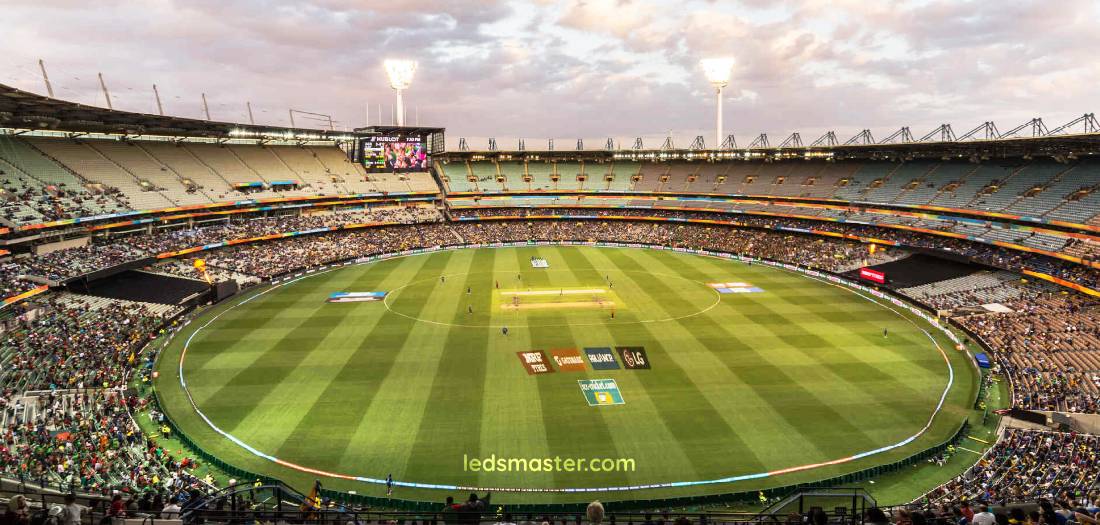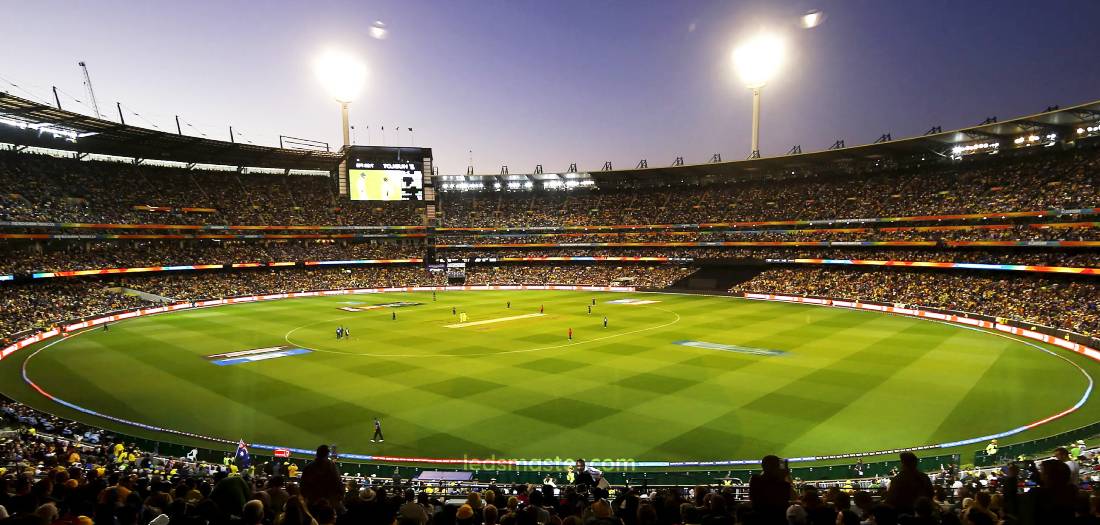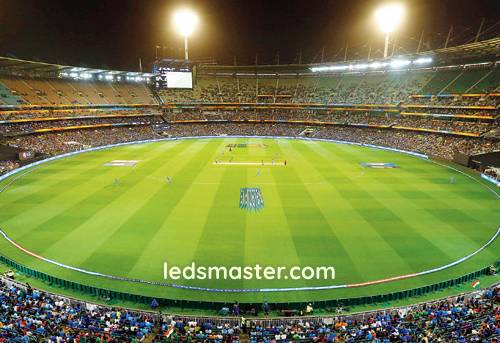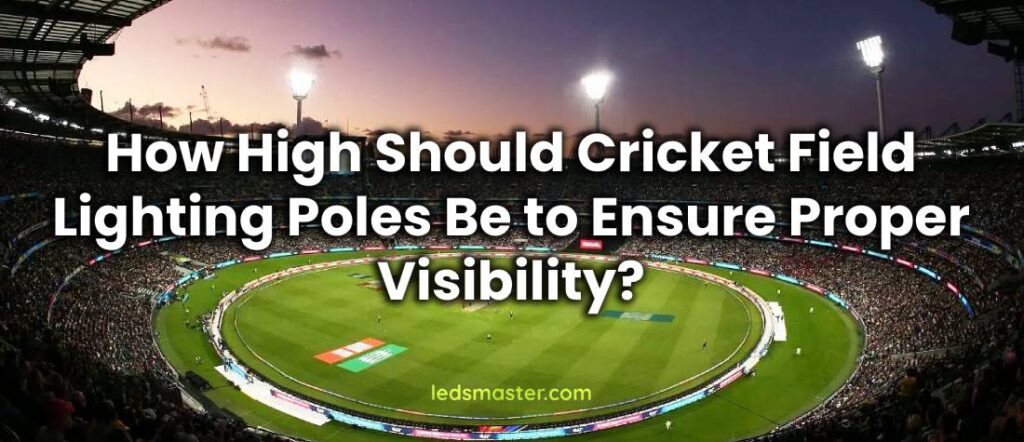In cricket, the quality of lighting can impact the overall experience for players, officials, and spectators alike. As a sport played over several hours, often during the evening or at night, it is important to ensure that lighting is appropriate to allow for fair play. However, the effectiveness of lighting largely depends on the height of the light poles installed around the field. Determining the optimal height for these poles is a complex task that involves various factors such as light distribution, glare, and safety considerations. This article will explore how tall cricket field light poles should be to maintain good visibility throughout the game.
| Type of Match/Location | Typical Pole Height | Field Size Consideration | Seating Capacity |
|---|---|---|---|
| Domestic/Local Matches | 30 meters | Smaller fields, compact layout | Lower seating capacity (1,000 to 10,000) |
| International Matches (Standard) | 40 to 50 meters | Medium to large-sized fields | Medium to high seating capacity (10,000 to 50,000) |
| International Matches (Large Stadiums) | 50 to 60 meters | Large fields, extended boundary areas | High seating capacity (50,000+) |
| Urban Location/Surrounding Buildings | 30 to 40 meters | Standard field size, controlled lighting spill | Varied, typically medium to high |
| Open or Rural Location | 40 to 60 meters | Large field size, minimal obstacles | Varies, often medium to high |
Table of Contents
ToggleFactors Affecting the Height of Cricket Field Light Poles
The height of light poles in a cricket field is not a random decision; it is influenced by a variety of factors that all contribute to ensuring that the lighting is even and effective across the field. These factors include the size of the field, the type of lighting fixtures being used, the level of play, and specific regulatory guidelines.

Field Size and Layout
The dimensions of the cricket field play a large role in determining how high the light poles need to be. A standard cricket ground has a diameter of about 150 meters, and a larger field will typically require taller poles to cover the entire area evenly. If the light poles are too short, there may be areas that are poorly lit, creating shadow spots where the ball becomes hard to see, especially during evening or night matches.
Lighting Fixtures
Modern cricket stadiums generally use LED floodlights due to their ability to provide bright, even light with low energy consumption. The type of light fixture influences how high the poles should be. LED lights with a wider spread can be mounted on shorter poles, while traditional halogen lights, which have a narrower beam, may need taller poles to distribute the light evenly across the field.
Level of Play and Venue Specifications
The height of the poles may also be influenced by the level of cricket being played at the venue. For international matches, the lighting requirements are more stringent compared to local or domestic matches. High-profile matches require lighting that provides consistent visibility without distractions such as shadows or bright spots. In some instances, local regulations may set specific requirements for the height and placement of lighting poles based on the venue and its location.
Standard Heights for Cricket Field Lighting Poles
The height of light poles for cricket fields varies considerably depending on the specific requirements of the stadium, the type of lighting system used, and the design of the venue. Cricket fields have different dimensions, and the lighting requirements must ensure adequate visibility for players, spectators, and TV broadcasts. Generally, the height of cricket field lighting poles is dictated by various factors including the size of the ground, the technological capabilities of the lighting, the location of the stadium, and the nature of the match being played. While there are no universal standards, specific ranges are typically followed to meet both performance and safety standards.
Typically, the height of cricket field light poles ranges between 30 meters and 60 meters. However, the height can vary widely depending on the size of the stadium, the type of matches being held, and the surrounding environment. For smaller domestic venues, the poles are usually on the lower end of the scale, around 30 meters, but for large international stadiums or venues hosting high-profile events, the poles may extend to heights of up to 60 meters or more.

Typical Heights for Domestic and International Matches
For local or domestic-level cricket matches, poles with a height of around 30 meters are typically sufficient. This height is well-suited for smaller stadiums or regional grounds, where the field dimensions are generally more compact, and the seating capacity does not exceed several thousand spectators. The 30-meter poles provide an adequate spread of light across the field, ensuring good visibility for both players and spectators. The light intensity is sufficient for day-to-night transitions, with floodlights ensuring that the game continues smoothly as daylight fades.
In contrast, for larger, international stadiums, poles are generally taller, ranging from 40 meters to 60 meters. The need for taller poles in these cases stems from several factors, such as larger field dimensions, higher seating capacities, and the expectation of hosting international events like World Cups or test matches, which are broadcast globally. The taller poles help spread the light more evenly over the expansive playing surface, ensuring consistent illumination from boundary to boundary and from the pitch to the stands. For instance, in iconic cricket stadiums like the Melbourne Cricket Ground (MCG) in Australia or Lord’s Cricket Ground in England, lighting poles can reach heights of 50 to 60 meters to adequately cover the extensive areas and cater to the large crowds often present at international fixtures.
Moreover, taller poles allow for the use of high-powered lights, which not only enhance visibility but also minimize shadows on the field, making it easier for players to track the ball and play their shots. The height also aids in reducing the glare that players would otherwise face, which can be especially problematic in day-night formats where the sun is setting and lighting is transitioning. This design choice ensures that the lighting quality meets the standards expected by both the players and the television audience.
Height Variations Based on Location
 The geographical location of a stadium plays a significant role in determining the ideal height of the lighting poles. In regions where the stadium is situated in an open and unobstructed environment, taller poles are often necessary to ensure that the light reaches all corners of the field, including the farthest boundary areas. For example, in many cricket grounds that are located in open spaces or in suburban locations with minimal surrounding structures, light poles might need to be positioned higher to cover larger areas effectively.
The geographical location of a stadium plays a significant role in determining the ideal height of the lighting poles. In regions where the stadium is situated in an open and unobstructed environment, taller poles are often necessary to ensure that the light reaches all corners of the field, including the farthest boundary areas. For example, in many cricket grounds that are located in open spaces or in suburban locations with minimal surrounding structures, light poles might need to be positioned higher to cover larger areas effectively.
In contrast, in densely built urban environments where a cricket ground is surrounded by buildings and other infrastructure, shorter poles may be preferred to avoid excessive light spill into neighboring spaces such as residential areas, roads, or businesses. Shorter poles help control light pollution, ensuring that the lighting system does not disturb the local community while still providing sufficient light to cover the cricket field. These decisions are often made in consideration of the local urban planning regulations and zoning laws, which seek to balance the needs of the stadium with the wellbeing of nearby residents.
The surrounding environment also affects the angle at which the lights need to be positioned. In locations with natural obstacles like mountains, hills, or large trees, the placement and height of poles may need to be adjusted to compensate for these barriers. For example, a cricket field located near a mountain may require poles that are higher to ensure that the lighting reaches all parts of the ground. Additionally, the climate of the region might influence the design of the poles, as areas that experience extreme weather conditions such as heavy winds or storms may require sturdier and taller poles to ensure they remain stable during adverse conditions.
Design and Engineering Considerations
When determining the height of lighting poles for a cricket field, engineers and designers also take into account the structural integrity and stability of the poles, particularly when they are placed at taller heights. The forces exerted by wind can increase significantly with height, so the design must ensure that the poles are sturdy enough to withstand these stresses. The poles are typically made of materials such as steel or aluminum, which offer the necessary strength and durability to support the weight of the lighting fixtures and resist corrosion caused by exposure to the elements.
Additionally, the safety of the players and spectators is paramount in these designs. The light poles must be designed in a way that they do not pose any risks in the event of a failure. For instance, in extreme weather situations, where high winds or lightning might pose a danger, the height and stability of the poles are carefully considered. Engineers also take into account the proximity of the poles to the playing field, ensuring they are far enough away from the playing area to avoid interfering with play or creating safety hazards.
Another consideration in designing the height of the poles is the ability to maintain and service the lighting system. Taller poles may present logistical challenges when it comes to maintenance, requiring the use of cranes or specialized equipment to replace bulbs or perform other maintenance tasks. Stadiums with higher poles often have access platforms installed to facilitate safe maintenance and repairs of the lighting fixtures without disrupting the game.
Recent Advances in Lighting Technology and its Impact on Pole Height
As lighting technology has evolved, especially with the widespread adoption of LED floodlights, the required height of poles has undergone some changes. LED lighting systems offer more efficient and targeted illumination than traditional metal halide or halogen lamps. These systems are not only energy-efficient but also produce less heat, making them ideal for use in cricket stadiums. Furthermore, LED lights can provide a more focused beam, meaning that the poles do not need to be as tall as they once were to achieve the same level of brightness and coverage.
For example, a stadium using traditional halogen lamps may have needed poles as tall as 60 meters to distribute the light adequately. However, with modern LED lighting, poles of 40 meters or even lower can still offer similar lighting coverage and intensity. This has led to more flexible and cost-effective stadium designs, especially for smaller venues that do not require the massive infrastructure of larger international stadiums.
In conclusion, while the height of cricket field light poles typically ranges from 30 meters to 60 meters, the actual height depends on several factors including the size of the stadium, the level of play, the surrounding environment, and the type of lighting technology used. Whether it’s a domestic match or an international fixture, the goal remains the same—to ensure that all areas of the field are properly illuminated, enabling players to perform at their best, spectators to enjoy the game, and broadcasters to capture the match under the best lighting conditions possible.
Technical Considerations in Lighting Design
Beyond the height of the poles, the technical design of the lighting system is a critical factor in ensuring proper visibility. Several engineering principles must be considered to achieve uniform lighting across the field.
Light Distribution and Angle
The angle at which lights are mounted on poles is a crucial factor in their effectiveness. Lights must be positioned at the correct angle to avoid creating shadows or hotspots on the field. Proper light distribution ensures that all areas of the field, including the outfield, infield, and boundary areas, are illuminated evenly. The height of the pole plays a direct role in determining the angle of the lights, as taller poles can cover larger areas with more even light distribution.
Glare Management
Glare is a common issue in sports lighting and can be a distraction to both players and spectators. The height of the light poles affects the severity of glare. Poles that are too short may result in direct glare into the eyes of players, especially during night matches. Taller poles help to position the lights higher in the air, reducing the potential for glare and ensuring that the players’ line of sight remains unobstructed.
Safety and Regulatory Standards
In addition to ensuring that the lighting provides good visibility, safety is a primary concern in the design and installation of cricket field light poles. International cricket boards and regulatory bodies often have specific standards that govern the height of light poles to ensure that the lighting system is both effective and safe for all involved.
International Cricket Council (ICC) Lighting Guidelines
The International Cricket Council (ICC) has set forth specific lighting requirements for international matches. These guidelines dictate the minimum illumination levels that must be met to ensure that the game is played under optimal lighting conditions. While the guidelines do not specify an exact height for the poles, they do recommend certain lighting characteristics, such as even light distribution, which may influence the height at which poles should be installed.
Structural Safety Considerations
Light poles must be designed to withstand various weather conditions, including strong winds and storms. Taller poles may be more vulnerable to wind forces, and thus they must be constructed with strong materials that can support the weight of the lights and resist any potential damage. Engineering safety standards ensure that the poles are installed securely, minimizing the risk of accidents during matches.
Technological Advances in Cricket Field Lighting
In recent years, technology has advanced significantly in the field of sports lighting. New developments in lighting technology, such as LED lights, have led to improved efficiency, brighter lighting, and better control over the spread of light. These technological advances have also had an impact on the height of lighting poles, allowing for more flexibility in design and installation.
LED Lighting and Its Impact on Pole Height
LED lights have a high energy efficiency and produce brighter light with less heat than traditional lighting systems. As a result, LED fixtures can be mounted at lower heights compared to older, bulkier light sources like halogen lamps. This means that stadiums using LED lighting may not require as tall poles, as the lights can still provide sufficient coverage even at lower heights.
Smart Lighting Systems for Better Control
Modern cricket fields are increasingly incorporating smart lighting systems, which allow for dynamic control over the intensity and direction of the lights. These systems can adjust the lighting to compensate for changes in weather or time of day. With smart technology, the need for excessively tall poles may be reduced, as the lighting system can adapt to different conditions to ensure optimal visibility.
Impact of Pole Height on Spectators and TV Broadcasts
While the height of cricket field light poles primarily concerns the players, it also has an impact on spectators and television broadcasts. The lighting system plays a significant role in providing a visually appealing experience for fans both in the stadium and at home.
Viewing Experience for Spectators
For spectators in the stadium, the height of the light poles influences the comfort and enjoyment of watching the match. Lights that are too low may result in a poor viewing experience, with shadows or glare obstructing the view of the game. By using appropriately tall poles, stadiums can ensure that all spectators, regardless of their seat location, have a clear and uninterrupted view of the match.
Television Broadcasts and Lighting Design
Television broadcasts of cricket matches require precise lighting to ensure high-quality footage. The height of the light poles can impact how well the game is captured on camera, especially in terms of eliminating shadows and maintaining consistent light levels. Broadcast lighting needs to be evenly distributed across the field to avoid areas that appear overly dark or bright on screen.
Determining the Optimal Pole Height for Specific Stadiums
Ultimately, the height of cricket field light poles should be tailored to each stadium’s specific needs. Factors such as field size, lighting technology, and even the layout of the surrounding environment play a role in determining the right height. Stadium designers work with engineers to create a lighting system that ensures proper visibility for players and fans, while also adhering to safety regulations.
Customizing Lighting Solutions for Unique Stadiums
Every stadium is unique, and a one-size-fits-all approach to lighting design doesn’t work. Some stadiums may have obstacles such as nearby buildings or trees that require different lighting strategies. For example, a stadium located in a densely populated urban area might need shorter poles to avoid disturbing nearby residential areas with excessive light. On the other hand, a stadium located in a wide-open space may benefit from taller poles to provide maximum coverage.
The height of cricket field light poles is a vital factor in ensuring that the game is played under the best possible lighting conditions. By considering the various elements such as field size, lighting technology, and safety standards, the optimal pole height can be determined. Whether it’s a local match or an international event, the right lighting can improve the overall experience for players, officials, and fans alike. It is a combination of careful planning, technological innovation, and practical considerations that helps achieve the right lighting solution for each cricket stadium.
Conclusion
Determining the height of cricket field light poles is a multifaceted decision that depends on various factors, including the size of the field, the type of lighting used, the location of the stadium, and the level of play. For smaller domestic venues, poles around 30 meters are usually adequate, while international stadiums often require poles ranging from 40 to 60 meters to provide consistent coverage for larger fields and higher seating capacities. The geographical location of the stadium plays a crucial role in this decision, as open spaces may necessitate taller poles for wider light distribution, whereas urban environments might call for shorter poles to prevent light spill. Advances in lighting technology, such as LED systems, have allowed for more efficient and targeted illumination, enabling shorter poles in some cases without compromising light quality. Ultimately, the goal is to ensure that all areas of the field, including the boundary and pitch, are well-lit, allowing players to perform optimally, spectators to enjoy the game, and broadcasters to capture the match clearly. With careful planning and consideration of these factors, the correct pole height can significantly enhance the cricketing experience for everyone involved.

